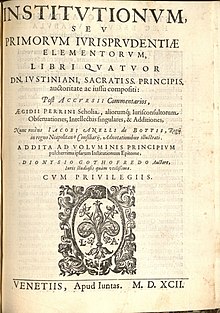Institutes (Justinian)

The Institutes (
Drafting and publication
Justinian's Institutes was one part of his effort to codify Roman law and to reform legal education, of which the Digest also was a part.
This new version of the Institutes was published on November 21, 533 and promulgated with the Digest on December 30, 533.[7] These new Institutes were not only a textbook for first year law students, but, according to the decree that promulgated them (C. Tanta), they carried the force of law.[8] First year law students used Justinian's Institutes as their textbook for centuries.[9]
Structure and content
The Institutes of Justinian is arranged much like Gaius's work, being divided into three books covering "persons," "things,", and "actions." Unlike the Digest, the extracts do not provide inscriptions indicating from whom the original material was taken.[10]
Modern editions and translations
Justinian's Institutes was largely unknown in the West. The earliest known manuscript are fragments of a Veronese palimpsest of the ninth century.[11] The first printed edition of Justinian's Institutes was Petrus Schoyff's in 1468.[12] Scholars using the Veronese palimpsest suggested changes to the existing text, and these criticisms resulted in the definitive texts by Paul Krüger and Eduard Huschke in 1867 and 1868 respectively.[13] The most frequently used modern version of Justinian's Institutes is that of Krüger,[14] which is in volume one of the Krüger, Mommsen, Kroll and Schoell stereotype edition.[15]
There are several translations of Justinian's Institutes into English, the better of the older ones being those of J.B. Moyle and Thomas Collett Sandars.[16] More recent translations by Birks & McLeod are also available as facing editions with Krüger's Latin.[17] Samuel Parsons Scott translated the Institutes into English as part of his translation of the entire "Corpus Juris Civilis," but his translation has not been well received.[18]
See also
References
- ^ See generally, Tony Honoré, "Justinian's Codification" in The Oxford Classical Dictionary 803 (Simon Hornblower and Antony Spawforth eds. 3rd rev. ed 2003).
- H. F. Jolowicz& Barry Nicholas, Historical Introduction to the Study of Roman Law 492-493 (3rd ed. 1972).
- ^ Id. at 492.
- ^ Tony Honoré, Tribonian 187 (1978), quoting Deo auctore.
- ^ Honoré, "Justinian's Codification, supra note 1, and Jolowicz & Nicholas, supra note 2 at 493
- ^ Honoré, Tribonian, supra note 3 at 189 (1978).
- ^ Jolowicz and Nicholas, supra note 2 at 493.
- ^ Id. at 492.
- ^ Honoré, "Justinian's Codification," supra note 1 at 804.
- ^ Id. at 493
- ^ A. Arthur Schiller, Roman Law, Mechanisms of Development 31 (1978). For a detailed account of the transmission of manuscripts of Justinian's Institutes through the medieval era, see Charles M. Radding & Antonio Ciaralli, The Corpus Iuris Civilis in the Middle Ages: Manuscripts and Transmissions from the Sixth Century to the Juristic Revival 111-131 (2007).
- ^ Schiller, supra note 10 at 31.
- ^ Id. at 32. Krüger's Justiniani Institutiones... is available in Europeana at [1].
- ISBN 978-65-88043-06-6.
- ^ Corpus Iuris Civilis (1877-1895) available in the Internet Archive at [2].
- ^ J.B. Moyle, The Institutes of Justinian (1893) available from Project Gutenberg at [3]; J.A.C. Thomas, The Institutes of Justinian (1975).
- ^ Birks, Peter & McLeod, Grant, Institutes of Justinian (Cornell University Press, 1987).
- ^ See Timothy Kearley, Justice Fred Blume and the Translation of the Justinian Code (2nd ed. 2008) 3, 21. Scott's translation is The Civil Law, including the Twelve Tables, the Institutes of Gaius, the Rules of Ulpian, the Enactments of Justinian, and the Constitutions of Leo... 17 vols. (1932) available at [4]. For a discussion of the work of Scott, Fred H. Blume, and Clyde Pharr on Roman law translation see Kearley, Timothy G., "From Rome to the Restatement: S.P. Scott, Fred Blume, Clyde Pharr, and Roman Law in Early Twentieth-Century," available at Social Science Research Network [5].
